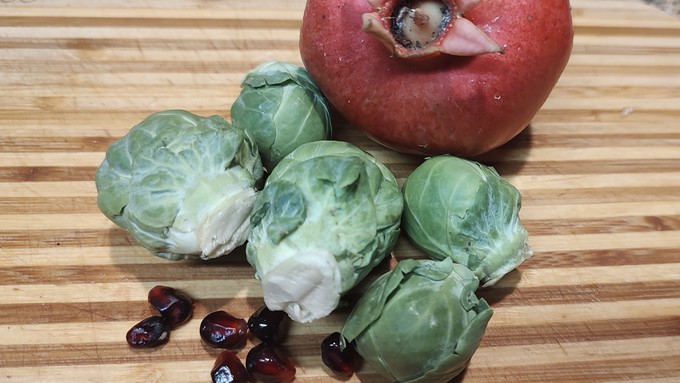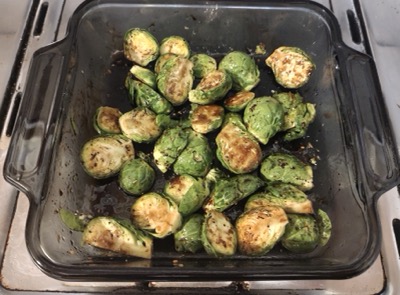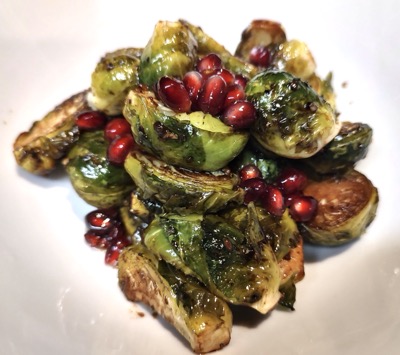
Recipe: Roasted Brussels sprouts with pomegranate

Brussels sprouts and pomegranate arils combine for a perfect holiday color combination. Photos by Debbie Arrington
Brussels sprouts and pomegranate – two late fall/early winter favorites – may seem like an unusual pairing, but this odd couple works surprisingly well in this cool-season side dish. And the color combination is perfect for the holidays.

I nicknamed this dish “rubied sprouts.” The pomegranate arils – the juicy seed sacs – look like little gems against the emerald green leaves of roast Brussels sprouts. Added just before serving, the pomegranate arils are warmed by the sprouts but don’t burst.
Pomegranate balsamic vinegar intensifies the sweet-tart flavor. (My vinegar came from Park Winters, www.parkwinters.com.) Other fruity balsamics such as fig would work as well.
Got company coming? This recipe can be doubled or tripled; just use a larger baking dish.
Roasted Brussels sprouts with pomegranate
Makes 3 to 4 servings
Ingredients:
2 cups Brussels sprouts, trimmed and halved
2 tablespoons extra-virgin olive oil
1 to 2 tablespoons pomegranate balsamic vinegar or other fruity balsamic vinegar
1 teaspoon lemon pepper
¼ teaspoon Old Bay seasoning
¼ cup pomegranate arils (seed sacs)
Instructions:
Preheat the oven to 350 degrees F.

In a shallow baking dish, place trimmed and halved Brussels sprouts. Add olive oil and stir to coat. Drizzle pomegranate balsamic vinegar over sprouts and stir gently. Sprinkle sprouts with lemon pepper and Old Bay seasoning; stir again.
Roast in a 350-degree oven until fork tender, stirring once (about 30 to 40 minutes, depending on size of sprouts).
Remove from the oven. Gently stir in pomegranate arils. Serve warm.
Comments
0 comments have been posted.Sacramento Digs Gardening to your inbox.
Food in My Back Yard Series
May 6: Maintain soil moisture with mulch for garden success
April 29: What's (already) wrong with my tomato plants?
April 22: Should you stock up on fertilizer? (Yes!)
April 15: Grow culinary herbs in containers
April 8: When to plant summer vegetables
April 1: Don't be fooled by these garden myths
March 25: Fertilizer tips: How to 'feed' your vegetables for healthy growth
March 18: Time to give vegetable seedlings some more space
March 11: Ways to win the fight against weeds
March 4: Potatoes from the garden
Feb. 25: Plant a fruit tree now -- for later
Feb. 18: How to squeeze more food into less space
Feb. 11: When to plant? Consider staggering your transplants
Feb. 4: Starting in seed starting
Sites We Like
Garden Checklist for week of May 11
Make the most of the lower temperatures early in the week. We’ll be back in the 80s by Thursday.
* Plant, plant, plant! It’s prime planting season in the Sacramento area. Time to set out those tomato transplants along with peppers and eggplants. Pinch off any flowers on new transplants to make them concentrate on establishing roots instead of setting premature fruit.
* Direct-seed melons, cucumbers, summer squash, corn, radishes, pumpkins and annual herbs such as basil.
* Harvest cabbage, lettuce, peas and green onions.
* In the flower garden, direct-seed sunflowers, cosmos, salvia, zinnias, marigolds, celosia and asters. (You also can transplant seedlings for many of the same flowers.)
* Plant dahlia tubers.
* Transplant petunias, marigolds and perennial flowers such as astilbe, columbine, coneflowers, coreopsis, dahlias, rudbeckia and verbena.
* Keep an eye out for slugs, snails, earwigs and aphids that want to dine on tender new growth.
* Feed summer bloomers with a balanced fertilizer.
* For continued bloom, cut off spent flowers on roses as well as other flowering plants.
* Add mulch to the garden to maintain moisture. Mulch also cuts down on weeds. But don’t let it mound around the stems or trunks of trees or shrubs. Leave about a 6-inch-to-1-foot circle to avoid crown rot or other problems.
* Remember to weed! Pull those nasties before they set seed.
* Water early in the day and keep seedlings evenly moist.